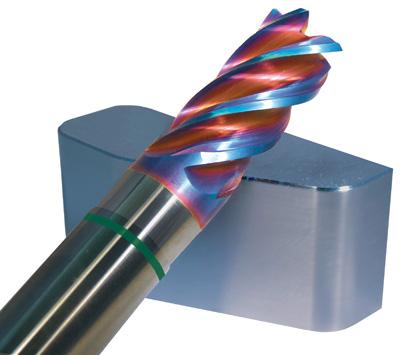
Without some sort of "turbo" attachment, you won't get far trying to dry-machine Inconel or titanium with a conventional end mill. In the form of the universal end mill series Turbomax, tool manufacturer InovaTools has reportedly delivered a multi-talented product. Thanks to its special geometry, chip control and coating, this product can achieve increases in productivity and quality improvements for dry machining of steel materials, Inconel and titanium in comparison to conventional tools.
As a genuinely universal all-rounder for trimming, roughing and finishing in mechanical engineering, the automotive industry, aeronautical and aerospace engineering as well as medical engineering and mold and tool construction, the Turbomax end mill from InovaTools proves its value in daily use.
Tobias Eckerle, technician at InovaTools: "The Turbomax end mills have an improved geometry with an uneven cutting edge spacing, a conical core diameter, 5 polished teeth and 1 tooth above the center. The bottom line is that, compared to similar tools from the Asian and German market, end milling can be performed with far lower levels of vibrations. This improves the surface quality and reduces the strain on the tool."
InovaTools also treats the Turbomax end mills to the company's own Naco-Blue coating and an additional end finishing. This smooth high-performance coating allows the chips to flow away very easily and also has a positive effect on the service life of the tools. This means that they no longer have to be changed as quickly, and cost-effectiveness is increased in an optimized process.
Turbomax is available in a range of diameters from 6mm to 20mm. The tools are available with HB and HA shanks, and wet and dry machining is possible up to less than 1,400 N/mm2/45 HRC.
In practice, the design advantages are reflected in the productivity levels. One example of this is in mechanical engineering, in the trimming of a motor housing made from non-rusting, austenitic steel, material 1.4301: compared to the 4 teeth in the reference tool, the Turbomax used has 5 teeth. With ap = 16mm, ae = 4mm, Vc = 80 m/min and N = 1,600 rpm, the Turbomax achieved a feed rate per tooth of fz = 0.08 compared to fz = 0.06 in the reference tool.
Tobias Eckerle said: "Depending on the application, the Turbomax offers customers a service life up to 2.5 times higher than that of the end mills they have used up to now. They can also increase their productivity by up to 50 percent using our universal end mills."
Contact Details
Related Glossary Terms
- Brinell hardness number ( HB)
Brinell hardness number ( HB)
Number related to the applied load (usually, 500 kgf and 3,000 kgf) and to the surface area of the permanent impression made by a 10mm ball indenter. The Brinell hardness number is a calculated value of the applied load (kgf) divided by the surface area of the indentation (mm2). Therefore, the unit of measure of a Brinell hardness number is kgf/mm2, but it is always omitted.
- feed
feed
Rate of change of position of the tool as a whole, relative to the workpiece while cutting.
- gang cutting ( milling)
gang cutting ( milling)
Machining with several cutters mounted on a single arbor, generally for simultaneous cutting.
- milling
milling
Machining operation in which metal or other material is removed by applying power to a rotating cutter. In vertical milling, the cutting tool is mounted vertically on the spindle. In horizontal milling, the cutting tool is mounted horizontally, either directly on the spindle or on an arbor. Horizontal milling is further broken down into conventional milling, where the cutter rotates opposite the direction of feed, or “up” into the workpiece; and climb milling, where the cutter rotates in the direction of feed, or “down” into the workpiece. Milling operations include plane or surface milling, endmilling, facemilling, angle milling, form milling and profiling.
- milling machine ( mill)
milling machine ( mill)
Runs endmills and arbor-mounted milling cutters. Features include a head with a spindle that drives the cutters; a column, knee and table that provide motion in the three Cartesian axes; and a base that supports the components and houses the cutting-fluid pump and reservoir. The work is mounted on the table and fed into the rotating cutter or endmill to accomplish the milling steps; vertical milling machines also feed endmills into the work by means of a spindle-mounted quill. Models range from small manual machines to big bed-type and duplex mills. All take one of three basic forms: vertical, horizontal or convertible horizontal/vertical. Vertical machines may be knee-type (the table is mounted on a knee that can be elevated) or bed-type (the table is securely supported and only moves horizontally). In general, horizontal machines are bigger and more powerful, while vertical machines are lighter but more versatile and easier to set up and operate.







